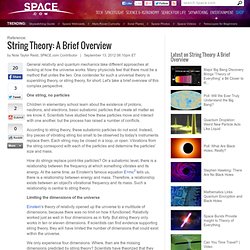

String Field Theory. Cosmic Superstrings Might Sing in Gravity Waves. The hunt for elusive gravitational waves has a new target: singing cosmic superstrings that theoretically emit the long-sought waves as they vibrate.

The superstrings are "so light that they can't have any effect on cosmic structure, but they create this bath of gravitational waves just by decaying," said Craig Hogan, a cosmologist with the University of Washington (UW). Gravitational waves, ripples of gravity caused by moving matter as it warps the fabric of space and time, were first theorized by Albert Einstein in his theory of general relativity in 1916, though the phenomena have yet to be observed in real time. String theory posits that hidden dimensions are tightly wound in strings of elementary particles. An offshoot of this theory suggests that some such strings can form into narrow tubes of energy stretched across vast distances by the expansion of the universe. "If we see some of this background, we will have real physical evidence that these strings exist," Hogan said.
String theory. String theory was first studied in the late 1960s[3] as a theory of the strong nuclear force before being abandoned in favor of the theory of quantum chromodynamics.

Subsequently, it was realized that the very properties that made string theory unsuitable as a theory of nuclear physics made it a promising candidate for a quantum theory of gravity. Five consistent versions of string theory were developed until it was realized in the mid-1990s that they were different limits of a conjectured single 11-dimensional theory now known as M-theory.[4] Many theoretical physicists, including Stephen Hawking, Edward Witten and Juan Maldacena, believe that string theory is a step towards the correct fundamental description of nature: it accommodates a consistent combination of quantum field theory and general relativity, agrees with insights in quantum gravity (such as the holographic principle and black hole thermodynamics) and has passed many non-trivial checks of its internal consistency. String Theory: A Brief Overview. General relativity and quantum mechanics take different approaches at looking at how the universe works.

Many physicists feel that there must be a method that unites the two. One contender for such a universal theory is superstring theory, or string theory, for short. Let's take a brief overview of this complex perspective. One string, no particles Children in elementary school learn about the existence of protons, neutrons, and electrons, basic subatomic particles that create all matter as we know it. According to string theory, these subatomic particles do not exist. How do strings replace point-like particles? Limiting the dimensions of the universe Einstein's theory of relativity opened up the universe to a multitude of dimensions, because there was no limit on how it functioned. We only experience four dimensions. Searching for evidence Whether string theory is the "ultimate" theory — the theory of everything — is unknown. . — Nola Taylor Redd, SPACE.com Contributor Further reading: Through the Wormhole: How Does the Universe Work?
With the help of massive machines called particle accelerators, scientists studied the subatomic realm and made discoveries about the forces that operate at that level.

But the search for a comprehensive explanation still continues. In particular, physicists have sought to find a way to reconcile Einstein's model of space-time, which seems to work best when applied to big objects like stars and galaxies, and the theory of quantum mechanics, which offers an explanation of electromagnetic and nuclear forces that makes sense of reality at the tiniest level. In recent years, some have proposed a novel solution called string theory, in which tiny particles are loops that vibrate like violin strings in a multidimensional space. In the mathematical calculations that make up string theory, gravitation is a byproduct of the process. Watch the full documentary now.